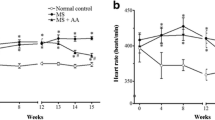Abstract
Summary. Among the antihypertensive drugs, fast-acting Ca2+ antagonists have been reported to worsen insulin sensitivity. This effect may be attributable to reflex increases in sympathetic activity. On the other hand, however, it has been reported that long-acting, dihydropiridine Ca2+ antagonists improve insulin-resistance. The purpose of this study was to investigate whether cilnidipine, another long-acting dihydropidine Ca2+ antagonist, improves insulin sensitivity in Otsuka Long-Evans Tokushima Fatty (OLETF) rat, a model of spontaneous NIDDM. 25 weeks OLETF rats were divided into the following groups; normal-diet group, cilnidipine-supplemented group (cilnidipine 3mg/kg/day) and angiotensin II receptor antagonist CS-866-supplemented group (CS-866 1mg/kg/day). As a non-diabetic control, we used Long-Evans-Tokushima-Otsuka rats (non-diabetic rats). Glucose infusion rate (GIR), an index of insulin resistance, as measured by the hyperinsulinemic euglycemic clamp technique was significantly decreased in OLETF rats. Cilnidipine-treatment partially but significantly improved insulin sensitivity in addition to systolic blood pressure in OLETF rats at 30 weeks of age, although it did not decrease accumulation of abdominal fat or serum levels of glucose or insulin. CS-866, an angiotensin 2 receptor antagonist, which lowers blood pressure through a different mechanism, did not improve insulin resistant states in OLETF rats. These results suggest that cilnidipine has a beneficial effect on insulin-resistance together with the antihypertensive effect.
Similar content being viewed by others
References
Modan M, Halkin H, Almog S, Lusky A, Eshkol A, Shefi M, Shitrit A, Fuchs Z. Hyperinsulinemia, a link between hypertension, obesity and glucose intolerance. J Clin Invest 1985;75:809–817.
Haffner SM, Fong D, Hazuda HP, Pugh JA, Patterson JK. Hyperinsulinemia, upper body adiposity, and cardiovascular risk factors in non diabetics. Metabolism 1988;37:338–345.
Reaven GM. Role of insulin resistance in human disease. Diabetes 1988;37:1595–1607.
Kaplan NM. The deadly quartet, Upper body obesity, glucose intolerance, hypertriglycemia, and hypertension. Arch Intern Med 1989;49:1514–1520.
DeFronzo RA, Ferrannini E. Insulin resistance A multifaceted syndrome responsible for NIDDM, obesity, hypertension, dyslipidemia, and atherosclerotic cardiovascular disease. Diabetes Care 1991;14:173–194.
Berne C, Pollare T, Lithell H. Effects of antihypertensive treatment on insulin sensitivity with special reference to ACE inhibitors. Diabetes Care 1991;14:39–47.
Kodama J, Katayama S, Tanaka K, Itabashi A, Kawazu S, Ishii J. Effect of captopril on glucose concentration. Possible role of augmented postprandial forearm blood flow. Diabetes Care 1990;13:1109–1111.
Giordano M, Matsuda M, Sanders L, Canessa ML, DeFronzo RA. Effects of angiotensin converting enzyme inhibitors, Ca channel antagonists and a adrenergic blockers on glucose and lipid metabolism in NIDDM patients with hypertension. Diabetes 1995;44:665–671.
Sheu WH, Swislocki AL, Hoffman B, Chen YD, Reaven GM. Comparison of the effects of atenolol and nifedipine on glucose, insulin, and lipid metabolism in patients with hypertension. Am J Hypertens 1991;4:199–205.
Tomiyama H, Kushiro T, Abeta H, et al. Kinins contribute to the improvement of insulin sensitivity during treatment with angiotensin converting enzyme inhibitor. Hypertension 1994;23:450–455.
Rosenthal T, Erlich Y, Rosenmann E, Cohen A. Effects of enalapril, losartan, and verapamil on blood pressure and glucose metabolism in the cohen-rosenthal diabetic hypertensive rat. Hypertension 1997;29:1260–1264.
Harano Y, Kageyama A, Hirose J, Asakura Y, Yokota T, Ikebuchi M, Suzuki M, Omae T. Improvement of insulin sensitivity for glucose metabolism with the long acting Ca channel blocker amlodipine in essential hypertensive subjects. Metabolism 1995;44:315–319.
Iimura O, Shimamoto K, Masuda A, Higashiura K, Miyazaki Y, Hirata A, Fukuoka M, Murakami H. Effects of a calcium channel blocker, manidipine, on insulin sensitivity in essential hypertensives. J Diab Comp 1995;9:215–219.
Kawano K, Hirashima T, Mori S, Natori T. OLETF (Otsukal Long Evans Tokushima Fatty) rat: A new NIDDM rat strain. Diabetes Res Clin Pract 1994;24 Suppl:S317–320.
Sakamoto S, Minami K, Niwa Y, Ohnaka M, Nakaya Y, Mizuno A, Kuwajima M, Shima K. Effect of exercise training and food restriction on endothelium dependent relaxation in the Otsuka Long Evans Tokushima Fatty rat, a model of spontaneous NIDDM. Diabetes 1998;47:82–86.
Ishida K, Mizuno A, Min Z, Sano T, Shima K. Which is the primary etiologic event of Otsuka Long Evans Tokushima Fatty rats, a model of spontaneous non insulin dependent diabetes mellitus, insulin resistance, or impaired insulin secretion? Metabolism 1995;44:940–945.
Rocchini AP. Insulin resistance and blood pressure regulation in obese and non-obese subjects. Hypertension 1991;17:837–842.
Zeng G, Quon MJ. Insulin-stimulated production of nitric oxide is inhibited by wortmannin: Direct measurement is vascular endothelial cells. J Clin Invest 1996;98:894–898.
Walker AB, Dores J, Buckingham RE, Savage MW, Williams G. Impaired insulin-induced attenuation of noradrenaline-mediated vasoconstriction in insulin-resistant obese Zucker rats. Clin Sci Colch 1997;93:235–241.
Draznin B. Cytosolic calcium and insulin resistance. Am J Kidney Dis 1993;21(6 Suppl 3):32–38.
Julius S, Jamerson K. Sympathetics, insulin resistance and coronary risk in hypertension, the “chicken and egg” question. J Hypertens 1994;12:495–502.
Pollare T, Lithell H, Selinus I, Berne C. Application of parzosin is associated with an increase of insulin sensitivity in obese patients with hypertension. Diabetologia 1988;31:415–420.
Author information
Authors and Affiliations
Rights and permissions
About this article
Cite this article
Harada, N., Onaka, M., Sakamoto, S. et al. Cilnidipine Improves Insulin Sensitivity in the Otsuka Long-Evans Tokushima Fatty Rat, a Model of Spontaneous NIDDM. Cardiovasc Drugs Ther 13, 519–523 (1999). https://doi.org/10.1023/A:1007827720807
Issue Date:
DOI: https://doi.org/10.1023/A:1007827720807




